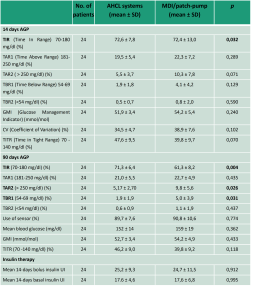Background: In type 1 diabetes mellitus (T1DM), initiation of Advanced Hybrid Closed-Loop (AHCL) systems has been linked to body weight increase. No studies compared body composition in patients using AHCL vs multiple daily insulin injections (MDI). Aim: To evaluate differences in body composition in patients with T1DM using AHCL with automated insulin delivery vs patch pump/MDI, and to investigate correlations with clinical data. Methods: We enrolled 24 patients (16 males; mean age 40±10 years) using continuous glucose monitoring in an explorative pilot study. Main inclusion criteria: T1DM duration ≥2 years, HbA1c<64 mmol/mol, BMI 18-30 kg/m2, weight stability in the last 6 months. Ten patients were under MDI therapy with a smartpen for recording rapid insulin doses, 2 used patch-pumps, and 12 used AHCL system for at least 1 year. Patients with MDI and patch-pumps were grouped together. The 2 groups (MDI/patch and AHCL) were matched by age, BMI, HbA1c, eGFR, and physical activity assessed by IPAQ questionnaire. All patients underwent bioelectrical impendence analysis to assess body cell mass (BCM), fat mass (FM), free-fat mass (FFM), FM/FFM ratio, total body water (TBW), extracellular water (ECW) and phase angle (phA), 3-points measurement of skinfold thickness, handgrip strength (by dynamometer), and Advanced Glycation End (AGE) products (via skin autofluorescence). Results: In patients under AHCL, time in range of the last 14 and 90 days was significantly higher than MDI/patch users, as shown in Table 1. In the entire cohort, BCM and TBW significantly correlated with total insulin (R=0,418, p=0,047, and R=0,418, p=0,047, respectively) and with basal insulin (R=0,586, p=0,003 and R=0,537, p=0,008, respectively), whereas FFM was correlated with basal insulin only (R=0,581, p=0,004). Handgrip strength was associated with cellularity indexes BCM% (p=0,036) and phA (p=0,030) in women, and with ECW in men (p=0,003). AGEs inversely correlated with BCM (R=-0,518, p=0,040) in men. Abdominal skinfold measurement was positively associated with FM (p=0,040) and showed an inverse correlation with FFM% (p=0,012). No significant differences were detected in handgrip strength, skinfold measurement, and body composition parameters between MDI/patch and AHCL group, even after sex stratification. Conclusions: Higher body cell mass was associated with higher basal insulin and, in men, lower AGEs. The use of AHCL systems was not associated with differences in body composition, when compared to a well-matched group of MDI users.


